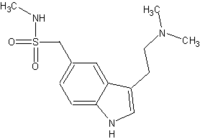RANCHO MIRAGE, CALIF. -- A new rapid-release formulation of sumatriptan has proved superior to placebo at relieving migraines within 2 hours when taken early in the attack, according to the findings of a randomized, double-blind, multicenter trial.
This formulation was developed for improved gastric disintegration and dispersion in order to overcome the gastrointestinal stasis that occurs with many migraine attacks. It has been available in the United States since January, Diane Boswell said at a meeting sponsored by the Diamond Headache Clinic.
In an intention-to-treat analysis, 66% of the patients who took 100 mg of the new formulation while their pain was still mild were pain free within 2 hours, compared with 51% of patients taking a 50-mg dose and 20% of patients taking the placebo. All differences were statistically significant.
This compares favorably with the action of conventional sumatriptan tablets, said Ms. Boswell, of the department of clinical development and medical affairs at Glaxo-SmithKline UK, which sponsored the study.
A total of 432 patients (359 women, 73 men) with a mean age of 41 years were included in the analysis: 142 in the high-dose group, 137 in the low-dose group, and 153 in the placebo group. The subjects, who experienced a mean of three migraines per month, were instructed to take the medication during the mild phase of a single migraine attack. Their mean time to treatment was 30 minutes. Attacks that started with moderate to severe pain were not studied.
The study's primary end point was complete absence of headache pain within 2 hours of taking the medication.
By 2 hours post treatment, 60% and 53% of the patients taking the 100-mg dose and 50-mg dose, respectively, said they were able to function normally at work or their usual activities, compared with 28% of patients in the placebo group.
Nausea and vomiting were the most commonly reported adverse events. The rate of all adverse events among patients taking the 100-mg formulation was 20%, compared with 14% among patients taking 50 mg sumatriptan and 12% among those taking the placebo.
BY NORRA MACREADY
Los Angeles Bureau
COPYRIGHT 2004 International Medical News Group
COPYRIGHT 2004 Gale Group



